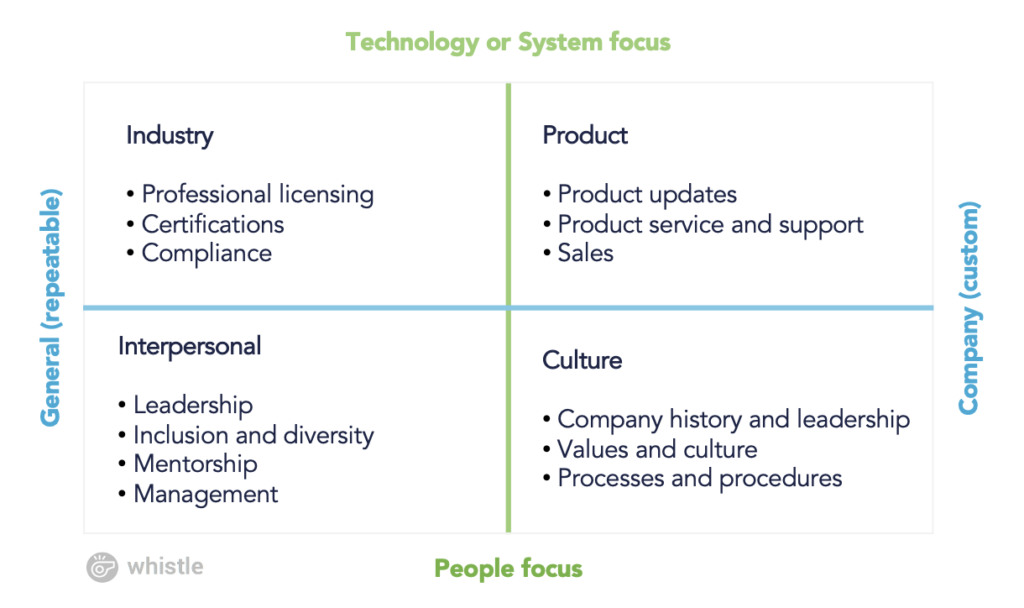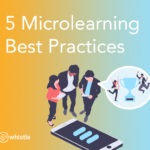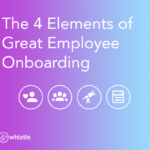The 4 Categories of Learning Content
A guide to building a complete employee training program
Companies under invest in employee learning, resulting in over $1T of value lost each year. Numerous studies and surveys have demonstrated the value of training investment: companies that invest effectively in people perform about twice as well when looking at metrics like employee retention, profitability and productivity.
The question many companies are trying to answer is: What does an effective employee training program look like?
To help answer this question, Whistle developed the Four Categories of Learning Content. Breaking down learning programs into these categories helps make clear the breadth of what needs to be provided and what can be provided by partners or developed in house.
There is an additional question around learning delivery or what technology should companies use to deliver effective training programs. The focus of this article is the content, not the delivery mechanism.
The Four Categories of Learning Content
Learning content can be organized along two continua. First, does the content relate to the industry in general, or is it organization-specific? Second, is the content focused on the practical or technical aspects of one’s work or is it related to more general “soft skills” such as leadership or decision making? If we cross these two axes, we can categorize content as falling into one of four categories.
- Industry content (the top left quadrant). This category represents all the things people need to learn that are common to the industry in which they operate. For many areas like finance or manufacturing this can involve specialized certificates or safety training that’s required to operate in the profession. Some training could be specific to a company but in most cases this information represents requirements mandated by industry groups, trade organizations or the government.
- Product Content (top right quadrant) is company specific information that is focused on the products or services offered by the company. This can be learning content about a product, how a product is supported or even the processes specific to how a company supports or delivers a solution in the marketplace. As an example, at a financial services firm, “industry content” could involve training about new government regulations that affect all firms. “Product content” would include training on the financial products and services that are unique to that particular firm.Product related content will often be shared (in some form) outside the organization to service partners, channel sales partners or even clients. Product related content can also change frequently as products and processes need to evolve frequently to keep up with an ever-changing marketplace.
- Cultural Content (lower right quadrant) is learning content that is specific to the organization, including the behaviors expected or expressed within it. This can include company history, cultural attributes or values or the systems and processes that help employees navigate their organizations.Employee onboarding is one of the most important parts of the culture content category at most organizations. However, when done well, onboarding encompasses all four categories of information.
- Interpersonal Content (lower left quadrant) centers on a person’s social or interpersonal development. In most cases this knowledge is highly transferable between any organizations and can cover a broad range of interpersonal topics. Leadership training, inclusivity, people skills, coaching and mentorship would all be examples of professional content training.
Putting it all together
Very few companies effectively address all four categories of training effectively. Most companies prioritize industry and product training categories over people because there are clear connections to growth or there are regulations requiring the training. This often comes at the expense of better people training that data suggests is more valuable to the business in the long term, but seems less obvious and urgent in the short term.
For example, a recent Whistle survey showed managers who received no management training reported 260% higher turnover on their teams than managers who received more than a day of training. Most companies are wasting millions of dollars by not giving managers and employees effective training, and they might not even know it. For companies who are interested in expanding the reach and impact of their learning programs to include all four categories of content, we recommend the following process as a good place to start:
- Assess the situation. A quick survey of management and employees can help you understand the learning gaps and the potential value of filling those gaps and offering an effective employee training program.
- Build the business case. Employee retention is a challenge for every company and even a slight improvement in retention can create a significant ROI for your organization. Replacing an employee typically costs about 35% of an annual salary (higher if training is more specialized). If an organization with turnover numbering around 1,000 people per year, making an average of $100K a year per employee, cuts attrition in half, it would save $17.5M in one year.
- Find a learning partner or partners. Your company is most likely an expert in its product, but not as well versed in the nuances of learning . Find learning technology and content partners who can help fill the gaps. Whistle for example has content partners who have already created professional and industry content for clients in a variety of industries.
- Build feedback mechanisms. Your learning program is a living and evolving effort. Build in the ability to collect feedback, develop insights and inform the constant improvement of your learning program. For example, Whistle integrated survey tools and a robust data visualization suite to make sure the value of learning content can be measured.
Get started today! Your people are your company’s greatest resource and investment. An effective employee training program will create value that impacts your organization in a myriad of important ways. You will learn more, build momentum and improve outcomes with each step you take.

Chris Dornfeld is the President and Co-founder of Whistle. With a background spanning several start-up companies, global corporations, higher education and government as the CIO for the City of St. Louis – Chris has a unique vantage point on engagement, culture, technology and our changing workexperience.
 Laurel Newman is a Co-founder of Whistle and a behavioral scientist at Edward Jones. Newman specializes in creating interventions that help companies to improve the experiences and change the behaviors of their customers and employees. Her experience as a Psychology Professor turned Applied Behavioral Scientist provides her unique insight into the variety of forces that impact people’s thoughts, feelings, and behavior.
Laurel Newman is a Co-founder of Whistle and a behavioral scientist at Edward Jones. Newman specializes in creating interventions that help companies to improve the experiences and change the behaviors of their customers and employees. Her experience as a Psychology Professor turned Applied Behavioral Scientist provides her unique insight into the variety of forces that impact people’s thoughts, feelings, and behavior.
Whistle is the first learning platform to integrate the key elements that drive business outcomes – ability (microlearning), motivation (micropayments and recognition), cues (AI informed nudges and recommendations) while removing friction (simplified design and mobile centric approach). Together these multiply the impacts of microlearning to maximize the impact on business outcomes.










